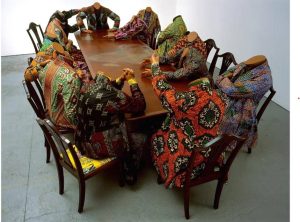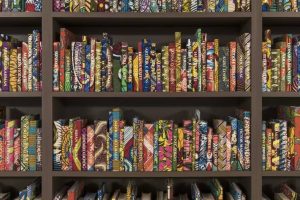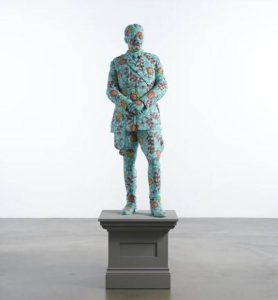Digvijay Nikam
Yinka Shonibare CBE RA, born in 1962, is a British-Nigerian artist exploring the issues of cultural identity, colonialism, and post-colonialism through his works in today’s globalized world. He was nominated for the Turner prize in 2004, commissioned to create an installation on Trafalgar Square’s Fourth Plinth in 2010, and was elected as a Royal Academician in 2013.

Courtesy of James Mollison
“What is African? And what is authentic African art?” These questions intrigued the mind of young Shonibare when his works at the Byam Shaw art school dealing with Perestroika in the Soviet Union were deemed an ‘inadequate expression of his self’ by his art tutor who said that the works didn’t have an element of his identity as an African. Since then, the question of ‘authenticity’ and often its dismantling has been a key focus in his vibrant array of work.
Early on in his career he was diagnosed with transverse myelitis, a disorder concerning the spinal cord which resulted in a long-term physical disability where one side of his body was paralyzed and therefore, his work is carried out under his guidance by his assistants. Shonibare’s oeuvre resists easy categorization given his experimentation with multiple media right from sculptures, paintings, drawings to photographs, films and installations. Central to his immensely beautiful and eye-catching works has been the use of Dutch wax fabric which holds special importance for him in conveying the politics of his art. Shonibare was astounded when he discovered that this fabric which is quintessentially associated with the African identity is an amalgamation of multiple histories and geographies. Originally inspired by Indonesian batik prints and produced by the Dutch and other European countries to be sold in the West African markets in the 19th and early 20th century which eventually led to it being considered an African fabric. The fabric, for Shonibare becomes a metaphor for contemporary African culture which is a mixture of things coming from different places and symbolises the complex ways in which the three continents – Europe, Asia, and Africa – are entangled to invent each other’s cultural identities. Yet these associations are forgotten regularly giving way to discourses of monolithic – authentic cultural

Courtesy of Yinka Shonibare
identities.
The history of slavery and colonialism has been momentous in creating these entanglements and hence, Shonibare’s approach has been to invoke, challenge, and often overturn these histories and its legacies using the Dutch/African wax fabric. A lot of his work involves recreating European dresses from the colonial period, scenes from historic paintings and his own original art works using this colourful African fabric which lends his work its essential uniqueness and subversive power.
Scramble for Africa (2003) is one of Shonibare’s most politically incisive work exploring the brutal history of colonisation. The work is an apt hallmark of the dynamic duality of his style which brings together beauty – in his imagery – and ugliness – in the stories of dominant power structures. It invokes the Berlin conference of 1884-85 which resulted in the carving up of the African continent by leading European and world powers. In Shonibare’s flamboyant reinterpretation, the heads of the various states – ironically dressed in African fabric and eagerly staking their claims – “are characteristically headless and equally mindless in their hunger for what Belgian King Leopold II called “a slice of this magnificent cake.”” However, this work was not just a reimagination of a historical event from the past but was created also to question the contemporary context of American imperialism and the hunger in the West to exercise hegemonic control over different parts of the world making one confront the repeating nature of history.

Courtesy of Yinka Shonibare
Immigration and multiculturalism as defining features of the modern world have also been central to his recent works given the ongoing debates in the United States about reduced immigration, the proposal to build a wall on the Mexican border and discrimination against certain groups despite their contributions to the country. Shonibare’s installation The American Library (2018) challenges these discriminatory tendencies by celebrating the enormous diversity of the American population. The installation does apt justice to this enormity by covering six thousand books with Shonibare’s signature Dutch wax fabric which serves as the perfect symbol for the multicultural identity of United States given its own mixed origins. The spine of each book is imprinted in gold with the names of celebrated individuals who immigrated to the United States, or of African-Americans who relocated from the American South during the Great Migration.
The individuals selected have contributed significantly to American cultural life and have been courageous in speaking out against inequality in America. Names featured include W. E. B. Du Bois, Maria Goeppert Mayer, Steve Jobs, Bruce Lee, Ana Mendieta, Joni Mitchell, Toni Morrison, Barack Obama, Steven Spielberg, Carl Stokes, and Tiger Woods.
Along with this his meticulously composed photographs and films recreate famous British paintings or stories from literature but with himself taking the centre stage as an alternative, black British dandy giving the originals a dissident turn. For instance, his Diary of a Victorian Dandy (1998) and Dorian Gray (2001) are reworkings of A Rake’s Progress by Hogarth and Oscar Wilde’s novel The Picture of Dorian Gray respectively.

Courtesy of Yinka Shonibare
Continuing his explorations in the history of colonialism and African identity he is currently exhibiting his most recent body of work, Decolonised Structures at the Sharjah Biennial 15 and, Modern Magic (in Pink) at the Cristea Roberts Gallery, London. The former recreates seven public statues of British imperialists draped in Dutch wax patterns whereas the latter pays homage to the African contributions to modernism.
References
https://artthrob.co.za/2022/11/23/self-and-soul-an-interview-with-yinka-shonibare-cbe-ra/
https://edition.cnn.com/style/article/yinka-shonibare-avant-garde-africa/index.html
https://www.mca.com.au/artists-works/exhibitions/yinka-shonibare-mbe/
https://www.themodern.org/exhibition/focus-yinka-shonibare-mbe
https://www.stephenfriedman.com/news/157-the-american-library-by-yinka-shonibare-cbe/
https://yinkashonibare.com/exhibitions/






